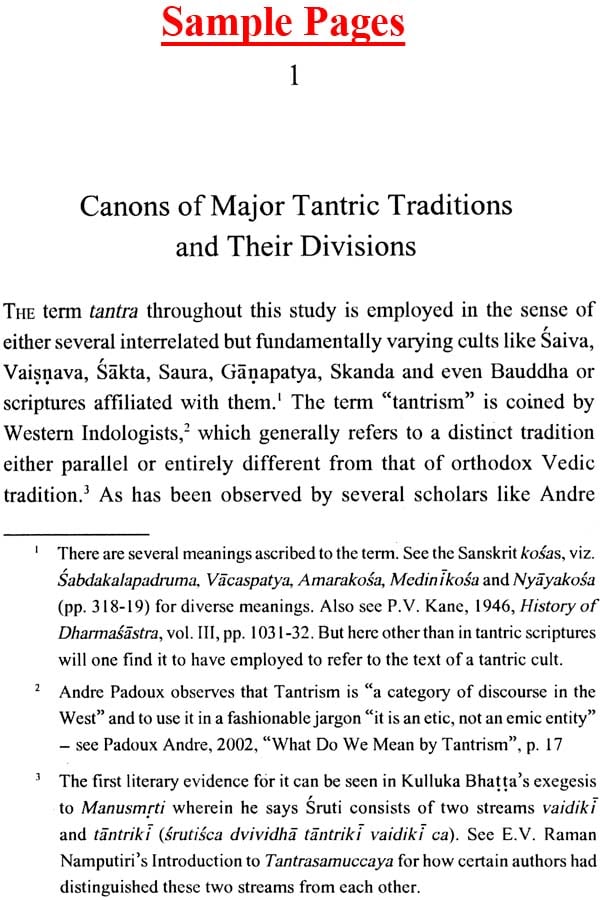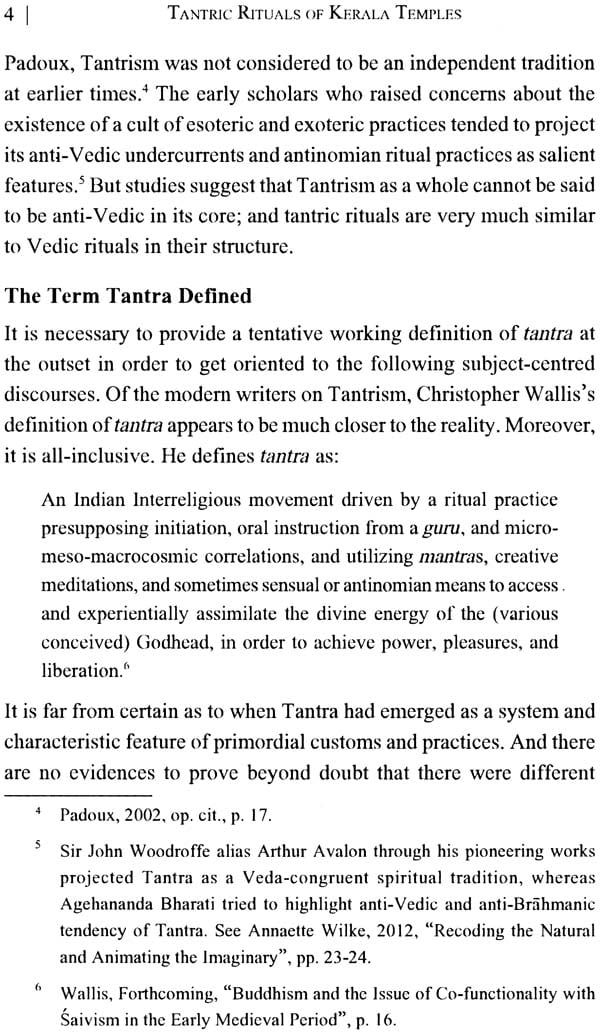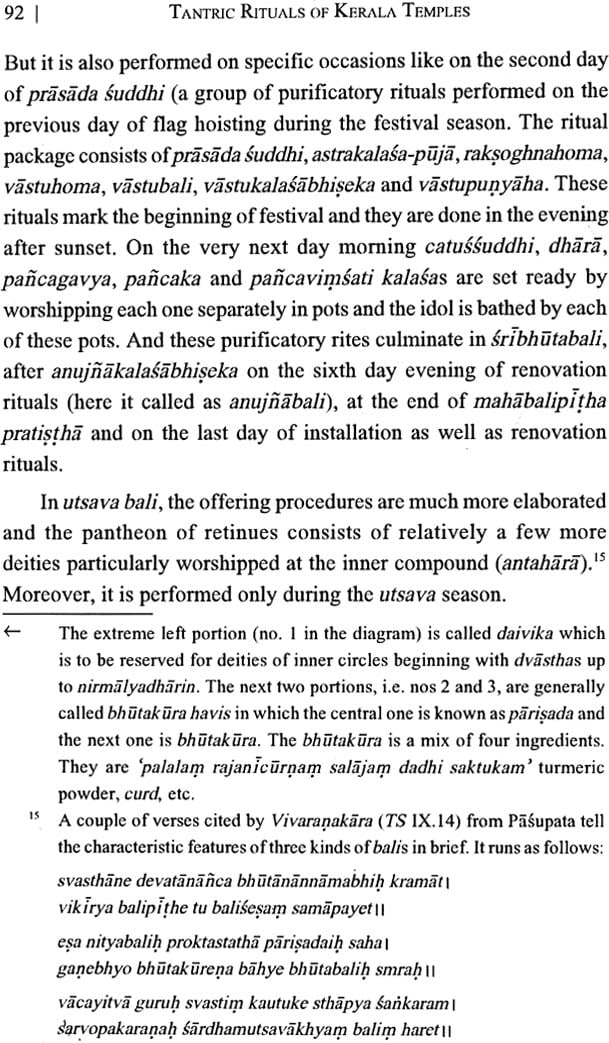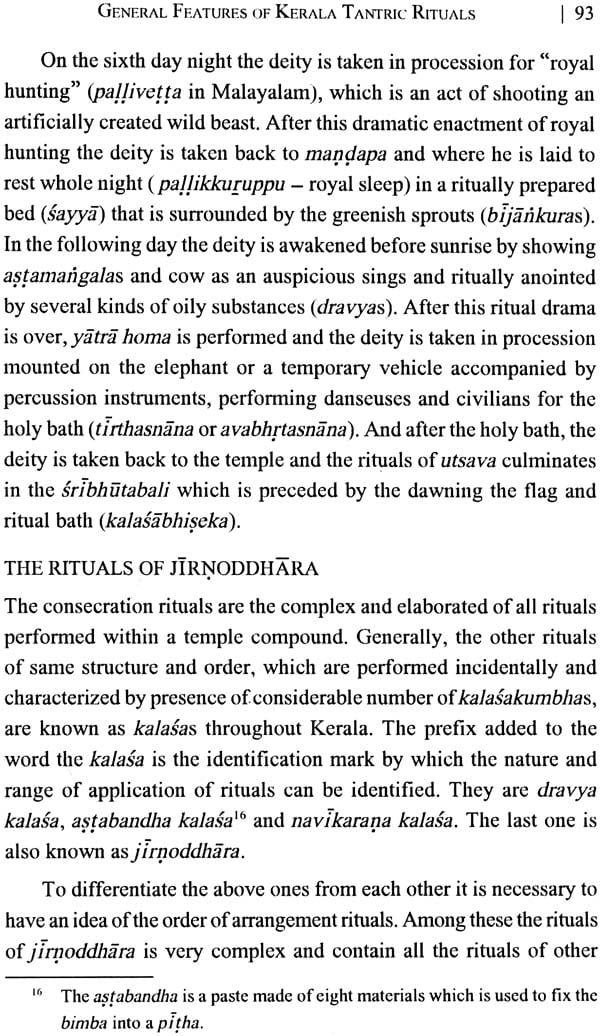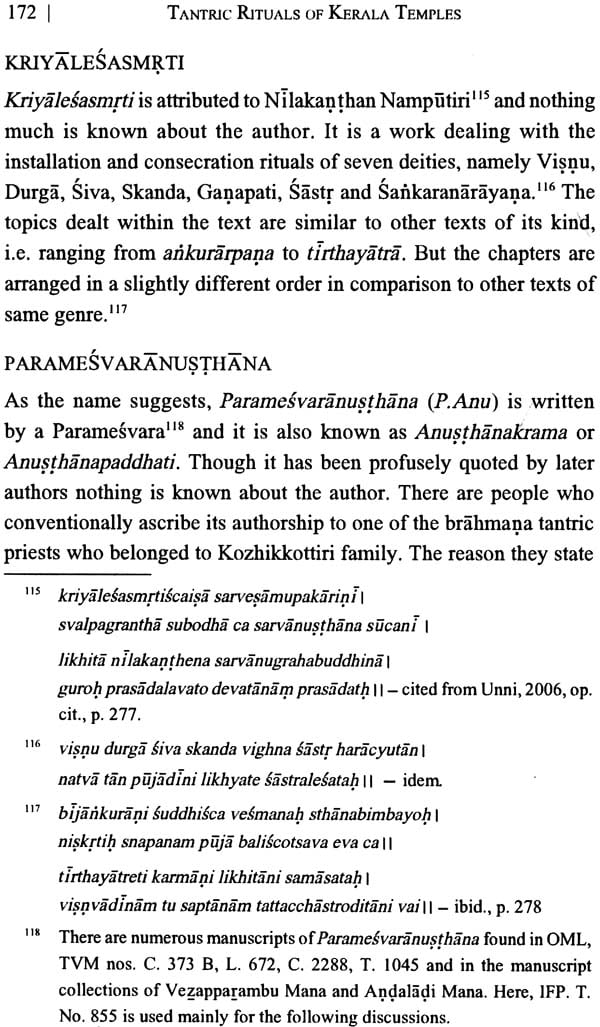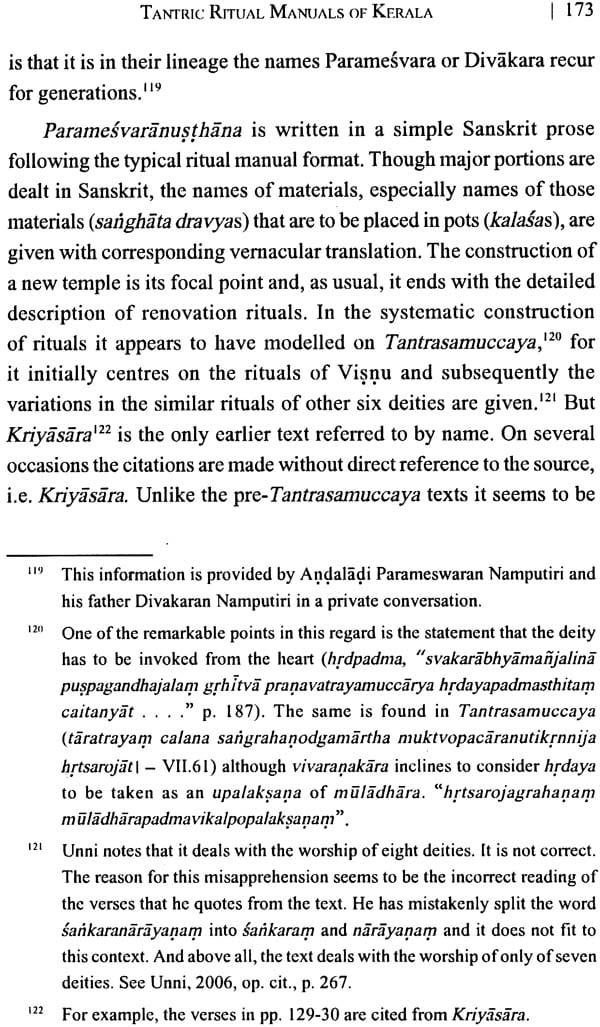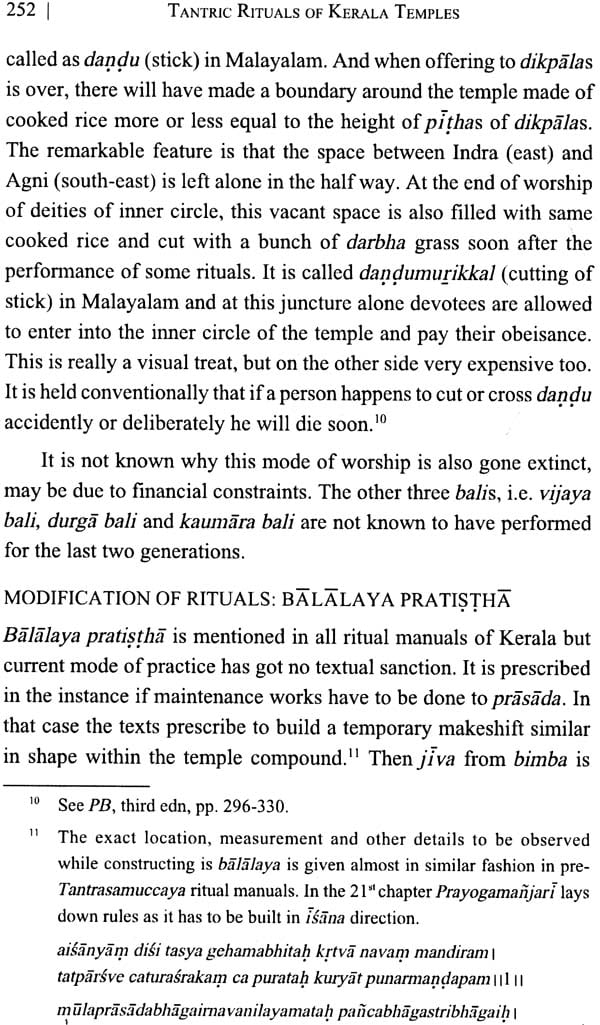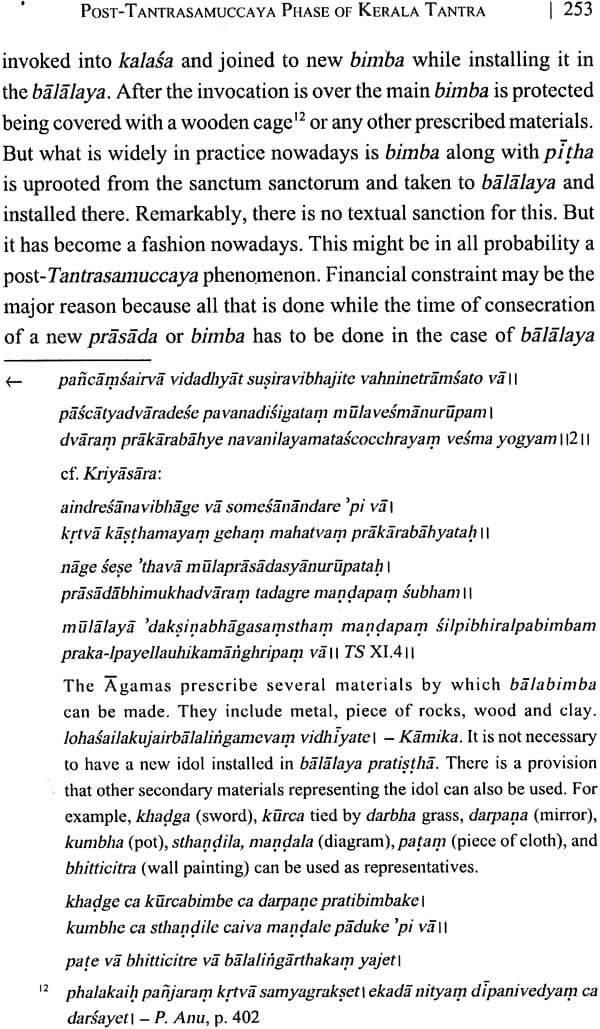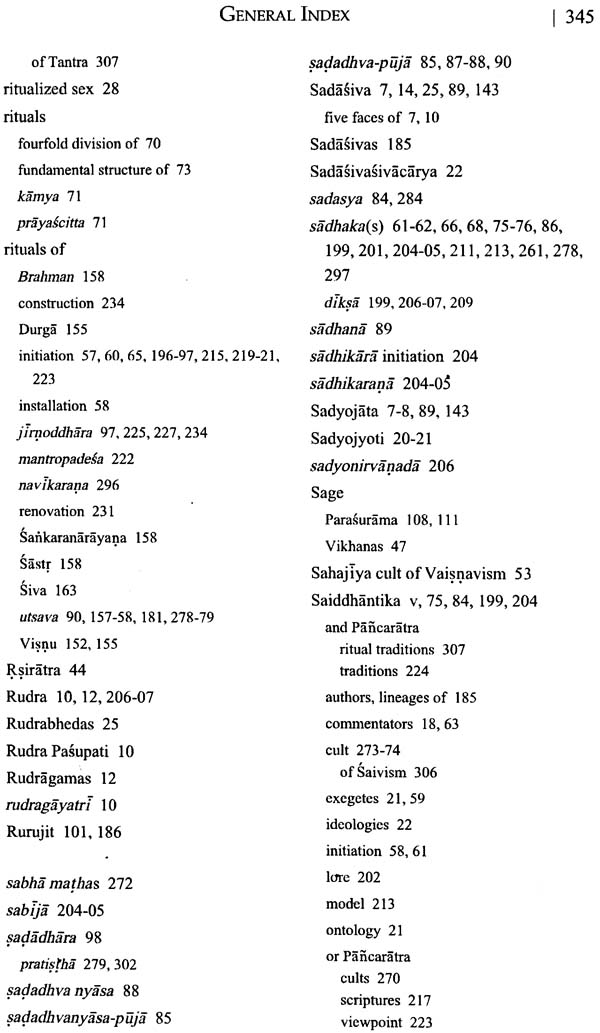
Tantric Rituals of Kerala Temples
Book Specification
| Item Code: | NAO074 |
| Author: | Ajithan P. I. |
| Publisher: | D.K. Agency, Delhi |
| Language: | English |
| Edition: | 2022 |
| ISBN: | 9788124608999 |
| Pages: | 377 |
| Cover: | Hardcover |
| Other Details | 9.0 inch X 5.5 inch |
| Weight | 650 gm |
Book Description
Kerala Tantra is a regional phenomenon which is an offshoot or synthesis 0f Saiddhantika and Pancaratra tantric ritual rites. It is a tradition deeply rooter within the Vedic ritualistic fold and characterized by Smarta-Pauranik beliefs and customs.
This volume is a general, but a serious and in-depth study of distinct temple ritual cult of Kerala. Kerala Tantra still remains to be a less explored subject There is no exclusive study on the ritual peculiarities of Kerala Tantra. This book focuses on filling that gap covering extensively the prominent characteristic of the unique ritual cult of Kerala.
The data presented in the book are based on many unpublished and less-known but authentic manuscripts of lat. medieval period, and interviews with previous and current generations 0f tantrins and their testimonies. It cover the great traditions of Tantra, Keral, Tantra, and transmission of tantric knowledge through formal and informal methods. It also talks about the. institutionalization of Tantric education taking a cue from the context of Vedic and Sanskrit education of Kerala.
Ajithan P.I. is a scholar in Tantra philosophy and rituals. He got his PhD for the thesis "Ritualistic Tradition of Tantra in Kerala" and degrees of MA and MPhil (in Sanskrit) from Sree Sankaracharya University of Sanskrit, Kalady, Kerala. He has to his credit half a dozen articles published in different journals. Dr Ajithan has attended numerous seminars and conferences, presenting papers. He had a short stint as Guest Lecturer, Department of Sanskrit, University of Calicut and chaired a session on Classical Literature in the 11th Prof. NVP Unithiri Endowment All Kerala Oriental Conference, 2016.
THE term tantra in its specific sense denotes traditions constituting diverging "cults" and their "sub-cults" and texts affiliated to them. Among well-known cults and sub-cults, Saiva, Vaisnava and Sakta are the prominent ones and found to have a pan-Indian appeal. It has been a subject long neglected but the post-Independence era has witnessed its phenomenal growth as an academic subject. The early studies of Sir John Woodroffe, Agehananda Bharati, Prabodh Chandra Bagchi, Gopinath Kaviraj, Vrajavallabha Dvivedi and Sanjukta Gupta were mainly dealing with general aspects of Tantrism. But present studies mostly revolve around specific aspects of tantric cults. To this category of specialized studies we can add the excellent academic studies of N.R. Bhatt, K'C, Pandey, Navjivan Rastogi, Helene Brunner, Alexis Sanderson, Mark Dyczkowski, Bettina Baumer, Dominic Goodall, Harunaga Isaacson, Diwakar Acharya, Peter Bisschop, Shaman Hatley, Jurgen Hanneder, Raffaele Torella, Gavin Flood and so on. Now Tantra remains one of the much advanced fields of studies in the South Asian religious studies.
The Kerala Tantra is a regional phenomenon which is, in a broader sense, an offshoot or synthesis of Saiddhantika and Pancaratra tantric ritual cults. It is a tradition deeply rooted within the Vedic ritualistic fold and characterized by Smarta-Pauranika beliefs and customs. There are many ritualistic tantric traditions, specifically familial traditions, in Kerala and none of them has independent existence outside the temple premises.
The present volume entitled Tantric Rituals of Kerala Temples: Texts and Traditions is a general study on the distinct temple ritual cult of Kerala. This is a revised version of my PhD thesis, The Ritualistic Tradition of Tantra in Kerala: A Study on Its Characteristic Features and Transmission, submitted to Sree Sankaracharya University of Sanskrit in 2014. The Kerala Tantra remains one of the subjects less explored even now. The scope of such a general study is that it is essential to have a general idea of the subject before one undertakes specialized study of a text or a particular cultural or historical phenomenon. The previous studies do not deal exclusively with ritual peculiarities of Kerala Tantra. Therefore an attempt is made in the present study to cover the prominent characteristics of the unique ritual cult of Kerala as extensively as possible.
The data collected from the scores of unpublished and less-known manuscripts constitute the major inputs of the present study. Many of these texts are of late medieval period and they are not enough to analyse present-day ritual scenario. Keeping this in mind several traditional tantrins of previous and current generations are interviewed and their words are analysed within a larger context.
The study is divided into three sections and it contains nine chapters altogether. The first section entitled "The Great Traditions of Tantra primarily focuses on surveying all the known scriptural divisions oftantric traditions and looking into general characteristics of tantric rituals. The background knowledge of canonical divisions is necessary to place Kerala Tantra within a broader context and subject it to a comparative analysis.
The second section entitled "Kerala Tantra", deals with the distinguished characteristics ofKerala tantric rituals. In five chapters it covers a wide range of topics extending from the detailed survey of the major ritual's, manuals and their characteristics and previous studies on the subject to post-Tantrasamuccaya ritual scenario. The third section entitled "Transmission: Formal and Informal Methods" focuses on how a performance-oriented tradition is transmitted orally in formal and informal educational settings. In two chapters an attempt is made to locate the traditional system of tantric education within the broader historical context of Vedic and Sanskrit education of Kerala. And the last chapter discusses how such education takes place in formal institutional contexts. The third section is followed by conclusion and a select bibliography. At the end photos of some of the ritual procedures are given as an Appendix. The present study would not have been possible without the help of several individuals who not only consist of academic scholars but also practising priests, friends and people who have made invaluable contributions in several possible ways. This book is a revised version of my PhD thesis that I have submitted to Sree Sankaracharya University of Sanskrit in 2014. First of all, I would like to thank Dr N.K. Sundareswaran, presently the Head of the Department of Sanskrit, University of Cali cut, under whose guidance I have carried out the study. I am highly indebted to him for his continuous support, patience, trust and proper guidance. His suggestions and observations helped me a lot in my endeavour.
I express my sincere thanks to Dominic Goodall, for giving me an opportunity to participate in Workshop on Nisvasatattva Samhita conducted at Pondicherry in 2011, that provided me with a great opportunity to see and interact with international scholars of excellent academic records like Alexis Sanderson, Harunaga Issacson, Diwakar Acharya, Shaman Hately, Peter Bisschop and so on.
| Preface | v |
| List of Tables and Figures | xvi i |
| Abbreviations | 1 |
| 13 | |
|
|
29 |
| 1. Canons of Major Tantric Traditions and Their Divisions | 3 |
| The Term Tantra Defined | 4 |
| Importance of the Guru and the Sastra | 5 |
| The Canonical Divisions | 6 |
| The Classifications of Sai vagamas | 6 |
| The Canons of Bhuta, Garuda and Varna Divisions | 11 |
| The Structure and Content of Siddhantagamas | 13 |
| The Provenance and Date of Composition | 18 |
| The Upagamas | 19 |
| The Paddhati Texts | 19 |
| The Saiddhantika Exegetes | 21 |
| Later Phase of Saiva Siddhanta | 22 |
| The Bhairava Tantras | 24 |
| Mantrapitha | 26 |
| Vidyapitha (Sakta-Saiva) | 27 |
| Yamala Tantras | 27 |
| Sakti Tantras | 29 |
| Mundrapitha | 35 |
| Mandalapitha | 35 |
| The Tantras of Kashrnir Saivism | 35 |
| The Spanda School | 36 |
| The Pratyabhijna School | 37 |
| Abhinavagupta and His Works | 38 |
| Commentaries | 38 |
| Independent Works | 38 |
| Hymns | 39 |
| Vaisnavism | 40 |
| The Classifications of Tantric Vaisnava Scriptures | 41 |
| The Pancaratra Cult | 41 |
| The Pnncariitra Literature | 42 |
| The Contents of the Sarnhitiis | 45 |
| The Vaikhanasa Cult | 46 |
| Classifications of the Vaikhanasa Literature | 47 |
| The Buddhist Tantra | 50 |
| Classification of the Buddhist Tantric Literature | 51 |
| The Tantric Cult of Bengal | 53 |
| The Buddhist Tantras of Bengal | 53 |
| The Sakta Tradition of Bengal: The Dasamahavidya Cult | 53 |
| The Tantras of Jainism | 54 |
| 2. Tantric Rituals: Their General Characteristics | 55 |
| The Ritual Elements | 56 |
| The Worshipper | 56 |
| The Initiation as a Cross-cultural Phenomenon | 56 |
| The Initiation in the Tantric Traditions | 57 |
| The Rituals of Initiation | 57 |
| The Saiddhanrika Initiation | 58 |
| The Signs of Saktipata | 60 |
| The Significance of Rituals of Initiation | 60 |
| The Categories of Initiation | 60 |
| The Saiddhantika Rituals of Initiation | 62 |
| The Efficacy of Rituals | 64 |
| The Non-Saiddhantika Initiation | 65 |
| The Vaisnava Initiation | 66 |
| Categories of Initiations | 67 |
| The Pancaratra Initiation | 67 |
| The Sakta Initiation | 68 |
| Ritual Space | 69 |
| Utensils used in Worship | 70 |
| Objects of Worship | 70 |
| Ritual | 70 |
| Fourfold Division of Rituals | 70 |
| Atmartha-Plija and Parartha-Puja | 74 |
| The Secret of Ritual | 77 |
| 3. General Features of KeraJa Tantric Rituals | 81 |
| General Features of Brahmanical Traditions of Tantra | 81 |
| Hierarchy of Priests | 82 |
| Two Kinds of Tantrins/Acaryas | 82 |
| The Basic Structure of a Ritual and Its Categories | 84 |
| The Ritual Space | 90 |
| The Rituals of Utsava | 90 |
| Kinds of Bali Offerings | 91 |
| The Rituals of Jiruoddbara | 93 |
| The Sakta Tradition of Muss ads | 100 |
| The Tantric Elements in the Folk Cultural Expressions | 102 |
| 4. Previous Studies on Kcrala Tantra | 106 |
| The Studies of Independent Scholars | 107 |
| E.V. Raman Namputiri | 107 |
| N.P. Unni | 116 |
| S.A.S. Sarma | 119 |
| Palakkal Madhavan (Madhavji) | 122 |
| Traditional Tantric Scholars | 123 |
| The Studies of Academic Scholars | 126 |
| Jayan Erancherry | 127 |
| K.M. Sangamesan | 127 |
| J.P. Prajith | 128 |
| R. Suthashi | 130 |
| 5.Tantric Ritual Manuals of Kerala | 132 |
| Ekadevata Pratisthii Tantras | 138 |
| Prayogarnanjari | 138 |
| Notable Features | 141 |
| The Pradyota Commentary | 143 |
| Saivagamanibandhana | 145 |
| Notable Features | 146 |
| Pasupata | 146 |
| Notable Features | 147 |
| Visnu Sarnhita | 149 |
| Notable Features | 151 |
| Kriyasarpgraha | 152 |
| Notable Features | 156 |
| Matrsadbhava | 156 |
| Caturdevata Pratistha Tantra | 157 |
| Nariiyanatrnaka | 157 |
| Notable Features | 158 |
| Saptadevata Pratistha Tantras | 160 |
| Kriyasara | 160 |
| Sivanusthana | 162 |
| Kriyadlpika or Putayurbhasa | 164 |
| Tantrasamuccaya | 166 |
| Commentaries on Tantrasamuceaya | 168 |
| The Less-known Commentaries ofTantrasamuccaya | 170 |
| Kriyii lesasrnrti | 172 |
| Pararnesvaranusthana | 172 |
| Tozanaranusthana | 174 |
| Karuttapajjinusrhana | 176 |
| Anusthanapaddhati | 178 |
| Astadevata Pratistha Tantras | 179 |
| Kuzikka ttupacca | 179 |
| Tantradarpana | 180 |
| Kainikkarapacca | 181 |
| Keralaiyaksetratantrakriyapaddhati | 182 |
| Vividhadevata Pratistha Tantras | 183 |
| Tsanasi vagurudevapaddhati | 183 |
| Sesasamuccaya | 186 |
| Tantrasesasamuccayanusthaua | 188 |
| The Disappearing and Expanding Rituals | 193 |
| Diksa (Initiation) | 195 |
| The Rituals of Initiation | 196 |
| The Texts on Initiation | 198 |
| Prayogamajijari | 198 |
| Suivagamanibandhana | 200 |
| Isanasivagurudevapaddhati | 202 |
| Definition of Dlksa | 203 |
| The Categories of Initiations | 203 |
| Vishnu Sarphitii | 209 |
| Matrsadbhava | 213 |
| Kriyasilra | 214 |
| Putayarbhasa | 215 |
| Tantrasamuccaya | 217 |
| Kriyasarpgraha | 220 |
| Kugikka Hupacca | 221 |
| Koraliyaksctratantra kriyapaddhati | 222 |
| Summary | 222 |
| Jirnoddhara | 223 |
| 7. The Post-Tantrasamuccaya Phase of Kerala Tantra | 233 |
| The Structure and Content of Tantrasamuccaya | 234 |
| Eclectic Nature | 235 |
| Aim of Composition | 235 |
| Advantages and Disadvantages of Generalization | 236 |
| The Political Milieu and Inclinations of Tantrasamuccaya | 237 |
| TATRIC RITUALS OF KERALA TEMPLES | 240 |
| Later Phase of the Tantrasamuccaya Tradition: | 241 |
| Texts and Authors | 243 |
| Other Anusthanas and Their Importance | 244 |
| Irinjalakuda Tradition | 245 |
| The Post- Tantrasamuccaya Kerala Tantra Scenario | 246 |
| Inclusion of the New Ritual Elements | 247 |
| Bahuvera Vidhana | 248 |
| Asvatthopanayana and Mrdangopanayana | 249 |
| Redefined Role of Astrologer | 249 |
| Verpatu-Puja | 251 |
| Preface | 251 |
| List of plates | 251 |
| Introduction | 251 |
| Historical Study: Hinayana and Mahayana | 252 |
| Outline of Political History, Socio-Economic and Religious | |
| Changes in India from 300-700 CE: The Transition Period | |
| Political and Economic Background and the Spread of | |
| Esoteric Buddhism in Early Medieval Period India | 257 |
| Emergence of Vajrayana | 257 |
| Vajrayana Images | 258 |
| Conclusion | 259 |
| Glossary of Buddhist Terms | 262 |
| Bibliography | 262 |
| Index | 263 |
| Temples and the Society | 267 |
| Role of Acarya!Tantrin in Temples and the Society | 270 |
| Education System in Kerala: A Hawk's Eye-View | 271 |
| Kerala Tantra: Texts on Informal Mode of Transmission | 273 |
| Mantropadesa Replaces Dlksa | 274 |
| Contexts of Learning | 276 |
| Stages in Learning Rituals | 279 |
| Textual Transmission | 280 |
| Disadvantages of Traditional Methods | 283 |
| Traditional Tantrins of Scholarship and Fame | 283 |
| Andaladi Divakaran Narnputiri Padu | 284 |
| Putumana Damodaran Namputiri | 285 |
| Kalppuga Divakaran Nampatirippudu | 287 |
| Kallur Narayanan Namputiri | 288 |
| Vezappajambu Pararnesvaran Namputiri | 288 |
| 9. Formal Transmission: Brahmanlcal and Non-Brahmanlcal Institutions | 289 |
| Emergence of Tantric Institutions in Kerala | 293 |
| Brahrnanical Institution: Emergence of TVP | 293 |
| Non-Brahmanical Institutions | 298 |
| Koru Asan Smiiraka'Vaidika Sangharn | 299 |
| Gurupadam | 302 |
| The Organization of Tantrins | 304 |
| Conclusion | 306 |
| Bibliography | 310 |
| General Index | 330 |
| Title Index | 354 |
